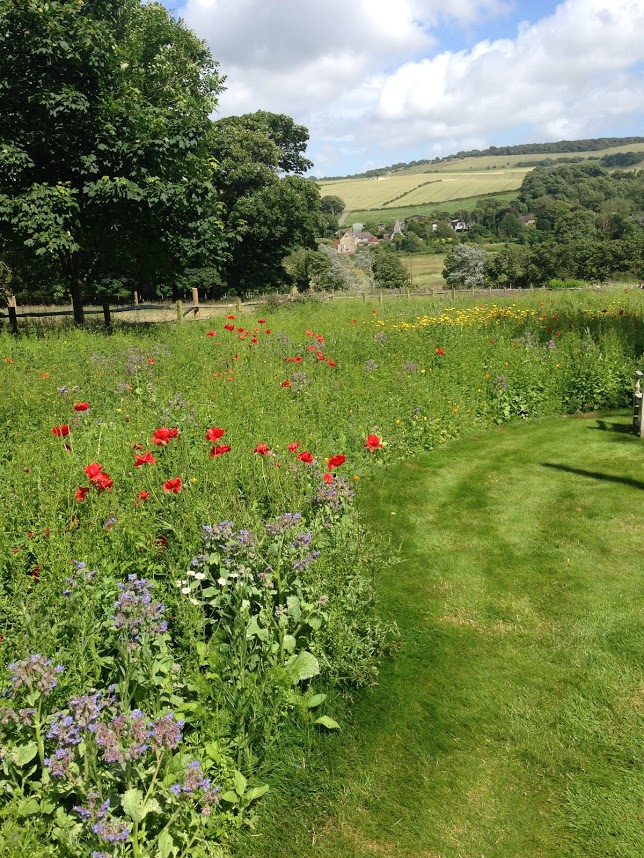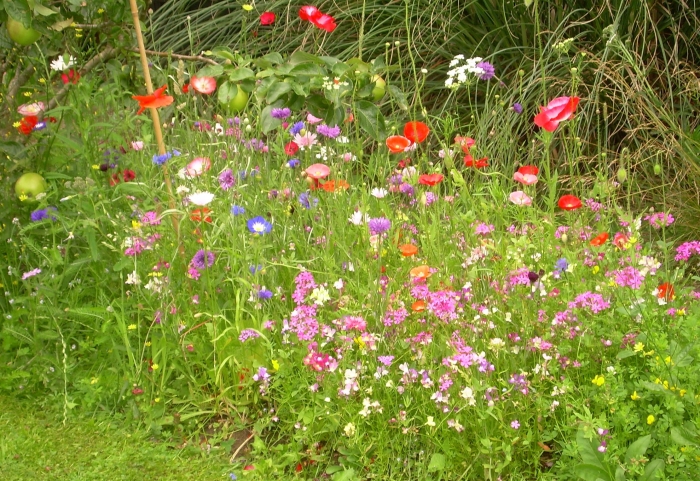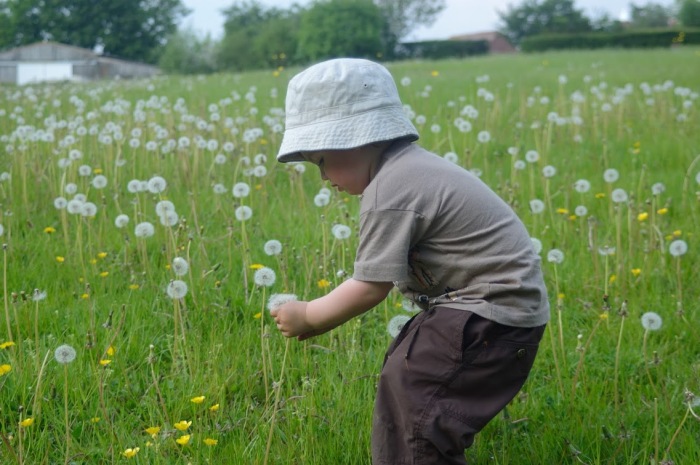
‘And that will be England gone, the shadows, the meadows, the lanes….. all that remains for us will be concrete and tyres’
On holiday recently, passing mile upon mile of road-side verges sprayed with weedkiller, I couldn’t help thinking of these ringing words from Philip Larkin’s disturbing poem ’Going,Going’. Even back in 1972 he was warning of the way we are trashing our environment. Those sprayed verges are understandable as part of essential high-way maintenance yet, in a way, deeply disturbing. With the road-sides looking like a ‘scorched earth’ policy it raises the question ‘Where have all the wild flowers gone?‘

Where have all the wildflowers gone?
97% of our traditional wildflower meadows have gone. They have been replaced by arable, grazing pasture, or silage, which is so much easier to produce than hay, which was always so susceptible to wet weather conditions. The result, regrettably, is that these intriguing, quaint names have largely faded from our countryside vocabulary:
Ragged Robin, Rest Harrow, Shepherd’s Purse, Sheep’s bit Scabious, Lady’s Bedstraw, Cuckoo Flower, Jack by the hedge , Self-heal, Bird’s foot trefoil, Traveller’s Joy/Old Man’s Beard.
These charming unsung hidden gems, are forgotten treasures, full of the memories of the past. These plants have been around for centuries and we should treasure them as the old poets did.
‘To me the meanest flower that blows Can give thoughts too deep for tears‘ – Wordsworth’s ‘Ode to Immortality’

Creating Wildflower Meadows
With the benefits field margin and verge flowers bring it is good to see the efforts some farmers are making to encourage wildflowers on their field margins and hedgerows.
Miriam Rothschild led the way with her pioneering fields of wildflower meadows. She developed a wildflower seed mixture that was mischievously called ‘Farmer’s Nightmare’! Under her inspiration, HRH Prince Charles has also become an advocate of the cultivation of these traditional flower-rich ‘meads’. There’s a photo in my copy of the book on the Highgrove estate of the Prince helping to operate the horse-drawn hay cutter in one of the meadows in his grounds.
‘Crown’d with rank fumiter and furrow-weeds,
With bur-docks, hemlock, nettles, cuckoo-flowers,
Darnel, and all the idle weeds that grow
In our sustaining corn.’
Shakespeare’s King Lear (4.4.2-6)Farmer’s nightmare indeed!
In the gardens at Great Dixter, Christopher Lloyd maintained a number of wildflower meadows and, after several decades, they now have a rich variety of flora. Seeing the uncut front grass, a visitor to Dixter once commiserated with Christopher on his not being able to employ help cutting the front grass! But that’s just the point, wildflower or flower -rich grass does not need cutting except for once a year!
For those gardeners trying to create wildflower meadows, Christopher’s inspirational book ‘Meadows’ is essential reading. Many of the old traditional meadows, now completely lost, took several centuries to develop their once rich flora!

My own experiment with ‘Pictorial Meadow’ mixtures (including some of the traditional annual weeds of corn crops) has been most encouraging. These mixes were widely used in the 2012 Olympic Park in East London and in roadside verges in several major towns and cities in the UK

In the Western Isles of Scotland where crofters have preserved the old practice of hay meadows, it’s fascinating to see the Corncrakes breeding successfully. Wouldn’t it be rewarding to see this very rare bird returning to other parts of Britain where it was once common.
‘Weeds’ are Wildflowers
Trained, as a horticulturalist, to combat weeds I’m now trying to value them (within reason!). They were here long before me – I play host to them — so why not get better acquainted with them. Each has its own charm and significance.
The following make an attractive garden display: Valerian , Chicory, Meadow Cranesbill, Evening Primrose, Teazle.

Even the humble dandelion, the bete noire of many gardeners, is a fine plant in flower and with its seed head ‘clocks’, the delight of children. For the gardener’s peace of mind they can be deadheaded to prevent the seeds spreading.
Each in its Place
Each wild flower has its own particular specific insect pollinators. The foxglove is designed for bumble bee access, while smaller insects are kept from raiding the nectar by small hairs. The nettle acts as host plant for 4 common butterflies. Just two examples of intimate and intricate niches and relationships all fitting together as so often in the natural world.

‘See how the lilies of the field grow. They do not labour or spin. Yet I tell you that not even Solomon was dressed like one of these‘
The words of Jesus in the ‘Sermon on the Mount’.
…….
Lesley sent me this photo with her comment. See below.

Good to see that a new housing development in Angmering has poppies and cornflower planted on its margins.
LikeLike
Thanks for sharing your comment Lesley. It shows that we, the public, notice such things. We wish more developers, local councils, and other planners of public places were much more ambitious in their wayside planting. We are tired of the boring formal schemes that we usually see. The Pictorial Meadows website shows some wonderful examples of what can be achieved by progressive local authorities.
Of course these annual poppies and cornflowers that you mention will need to be re-sown each year. I hope someone will do this !
-Richard
LikeLike
There isn’t anything quite like a meadow in flower, but we do have few around here. I’m pleased that our Council is now leaving patches of ground uncut to encourage wildflowers and planting patches of the same in various places. The small patches of untouched waste ground are often the places that seem to have the biggest variety and I hate to see them sprayed or cut back.
LikeLike
It’s so good to hear of your local meadows and of your Council’s enlightened policy. So called ‘waste’ ground can become a ‘wonderland’ of plant interest, if the mowers can be kept at bay!. It saves public money too. It saddens me when the cutters arrive to ‘shave’ the flower-rich verges outside our home.
– Richard
LikeLiked by 2 people
There’s nothing like a field of flowers. The lilies are my favorite flower so incredibly pretty photos.
LikeLike
Yes indeed. Flowers in their wild natural setting are always irresistibly photogenic. I too, wish I could get to see more of our rare and precious wildflower meadows.
LikeLiked by 1 person
Their the best🙂I through wild flower seeds all along the premises of my old garden.
LikeLike
Good for you. You remind me of the Victorian gardener, Miss Ellen Willmott, who used to scatter seed of her favourite Eryngium giganteum surreptitiously in other people’s gardens when visiting. A very good investment, as this Eryngium, now named ‘Miss Willmott’s Ghost’, has become a very popular garden plant !
LikeLike
Such an important post, Richard. There has been a movement to maintain meadows here in the U.S. with a great example near where I live of an old steel forge being repurposed into a performance space and the fields around it let go back to meadows. However, this week at my mother’s senior residence, someone complained that the hills behind the complex looked “weedy” and so they mowed down the beautiful meadow plantings. Heartbreaking.
LikeLike
It’s great to hear of that initiative converting the old forge and its surroundings. So sad that some ignorant person complained about the meadow areas. This development reminds me of the transformation of a derelict area of East London into the Olympic Park in 2012. It is now called the Queen Elizabeth Park and is full of trees, meadow areas and attracrive prairie style panting. At the week-ends crowds of local people enjoy this beautifull green space.
LikeLiked by 1 person
I couldn’t agree more Richard. I feel privileged, on reading your post, to say that other than Lady’s Bedstraw and Rest Harrow, we have all the others you mention growing in our garden or in the fields round about home.
Here are a few more: Eyebright, Scarlet Pimpernel, Pineapple Weed, Wild Strawberry, Comfrey, Silverweed, Fumitory , Willowherb and Wood Avens.
Also Sheep Sorrel which the Goldfinch are loving at the moment.
LikeLike
An impressive collection Clive. So good to hear that these plants are alive and well in your garden and local area.
LikeLike
Thanks for your comment. My maternal grandmother was what we might call a ‘herbalist’ (though as children we saw her as a white witch) and would gather many of the field and hedgerow plants for their medicinal uses. My Mum took this interest a step further and became a pharmacist! So I grew up knowing many of these plants and am very happy to give them space in the garden.
LikeLike
Knowledge of wild flowers seems to be a rare thing. these days. I’m glad you are keeping it alive.
LikeLike
Your post reminded me of an article (‘Nature Studies: Meadows are the wildflower experience taken to the ultimate power’) by Michael McCarthy writing in The Independent – June 2013 on ‘Coronation Meadows’.
Here is an excerpt:
… A traditional hay-meadow, reaching its peak just now, in June, presents a startling superabundance of floral life. There are so many blooms of so many colours, mixed in with so many waving grasses, that they blend into a rainbow mix that seems to be fizzing, a sort of animated chaos.
From the bright golden haze of the buttercups and yellow rattle, to the white of ox-eye daisies, the mauves and maroons and purples of clover, knapweed, wood cranesbill and spotted orchids, there can be as many as 150 species in one spot, and it’s the coming-together of them all which is extraordinary. It makes for a quite incomparable display of the sheer exuberance of the natural world. …
And my own tribute to our wildflower hay meadows: ‘In a Summer Meadow’
Lying lazy in a meadow by a stream
home to sheep ‘n’ cows and wagtail yellow
buttercups dance in the mowing grass so high above kestrel hover a flit of swallow …
wild rainbow cast the summer breeze
‘cross grasses mix’d an artists palette red gold ‘n’ green finches twitter ‘n’ tweeze;
the pipit sing of meadow flowers and hay
time flown the scream’n swift all hush’d as blackbird flute the end of day;
on the wing to Africa now the cuckoo fly
spotted orchid and bee no more still the hum of meadow ‘cept a Moorhen cry …
Lying lazy in a meadow by a stream
LikeLiked by 1 person
Glad you liked it Richard. Here’s the first part of the poem:
Lying lazy in a meadow by a stream:
the peal of distant church bells rings
across the summer meadows a lark ascending sings;
under a willow golden sunbeams flash
in the summer sunshine colours flying kingfisher splash;
yellow flags waving a gay summer tribe
of finches fluttering from leafy hedges bunting yeller cirl scribble ‘n’ scribe;
the furze linnet sing of summer love
in the air dandelion clocks timeless the gentle purr of turtle dove;
LikeLike